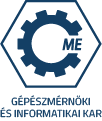| Course objectives: |
| The aim of the course is to learn the procedures and devices of mounting, the complex strategies of the assembly, and the planning methods of the assembly process. |
| Course content and structure: |
| General dimensional chain theory. Exchangeability theory. Accuracy of the assembly. Mounting technology correctness of designs. Theoretical basis of the assembly automatization. Ordering theory, degrees of freedom. Component delivery and assembly optimization. Motion analysis. Mounting procedures. Novel variants of tolerancing and joints. Assembly tools and devices. Assembly machines. Auxiliary equipment for mounting. The assembly sequences and systems. Planning of the assembly process. Modernization of the assembly: mechanization, automation, robotization. Quality assurance in the assembly. Designing of assembly systems. Flexible assembly systems. |
| Evaluation method: |
| Written and oral exam |
| Required reading: |
| 1. Daniel E. Whitney: Mechanical Assemblies, Oxford University Press, 2004, p5172. Schey,J.A.: Introduction to manufacturing processes, McGraw-Hill Company,1987.3. Paskova, E.V.: Robototekhnicheskie sistemü v sborochnomproizvodstve, Izd. Visha shola, 1987. |
| Suggested reading: |
| 1. Andreasen M.M. - Kahler S. L. und T.: Design for Assembly, Springer Verlag, Berlin, 1983.2. Rathmill, K.: Robotic Assembly, Springer Verlag, Berlin, 1985.3. Annals of the CIRP (1990-2000)4. Brankamp, K.: Gyártási és szerelési kézikönyv, Budapest, Műszaki Könyvkiadó, 1980.5. Németh, T.: Gépipari szerelés, Budapest, Műszaki Könyvkiadó, 1981.6. Vraukó, L.: A gépipari szerelés néhány kérdése, BME, Továbbképző Intézet |


